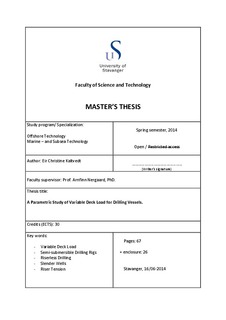| dc.contributor.author | Kaltvedt, Eir Christine | |
| dc.date.accessioned | 2014-09-12T13:20:58Z | |
| dc.date.available | 2014-09-12T13:20:58Z | |
| dc.date.issued | 2014-06-16 | |
| dc.identifier.uri | http://hdl.handle.net/11250/219665 | |
| dc.description | Master's thesis in Offshore technology | nb_NO |
| dc.description.abstract | The size of semi-submersible drilling rigs has tripled over the past 50 years, with corresponding increase in cost. In order to change the direction of this development, the size of the rigs has to be challenged. Utilizing new technologies is the key for succeeding. By reducing the required variable deck load (VDL), existing rigs could increase their capacity, and the size of the future rigs could be reduced without jeopardizing their operational capacities.
This thesis presents a parametric study of the VDL where the objective is to identify technologies that can reduce the required VDL, and attempt to quantify reduction potentials for key contributors of the required VDL. Theoretical background for the semi-submersible drilling rigs and VDL is presented. The identified technologies are presented and their reduction potential is established and discussed, as well as the increased operational capacity due to the identified technologies. The focus has been on technologies that can reduce the key contributors of the VDL.
The capacity of the drilling rig Maersk Deliverer, together with the characteristics of the drilling rigs on the market today was used as a basis to identify the largest contributors of the VDL and the potential increase in capacity.
The results show that there is potential to reduce the required VDL by applying new technologies. For existing rigs this means increased operational capacity, e.g. a 4th generation drilling rig has the potential to operate within the same operational range as a 5th generation drilling rig. The reduction in required VDL also leads to more free storage space, which is an advantage when drilling in remote locations. For the development of future generations of drilling rigs the results indicates that the size can be reduced without decreasing the operational capacity. | nb_NO |
| dc.language.iso | eng | nb_NO |
| dc.publisher | University of Stavanger, Norway | nb_NO |
| dc.relation.ispartofseries | Masteroppgave/UIS-TN-IKM/2014; | |
| dc.rights | Attribution-NonCommercial-NoDerivs 3.0 Norway | * |
| dc.rights.uri | http://creativecommons.org/licenses/by-nc-nd/3.0/no/ | * |
| dc.subject | variable deck load | nb_NO |
| dc.subject | semi-submersible drilling rigs | nb_NO |
| dc.subject | riserless drilling | nb_NO |
| dc.subject | riser tension | nb_NO |
| dc.subject | slender wells | nb_NO |
| dc.subject | undervannsteknologi | nb_NO |
| dc.subject | subsea technology | nb_NO |
| dc.title | A parametric study of variable deck load for drilling vessels | nb_NO |
| dc.type | Master thesis | nb_NO |
| dc.subject.nsi | VDP::Technology: 500::Marine technology: 580::Offshore technology: 581 | nb_NO |

